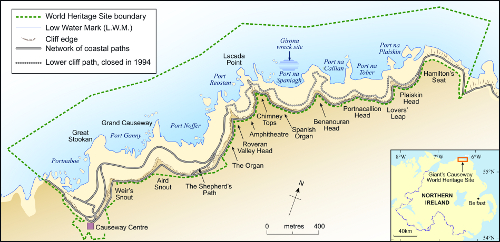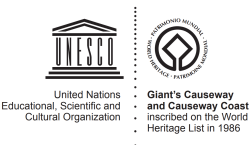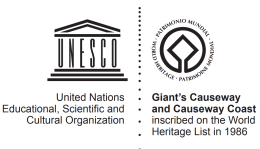Where it is…
The Giant’s Causeway and Causeway Coast WHS is located on the North Coast of County Antrim, Northern Ireland. The Site extends approximately 3km in length and 0.5km in terrestrial width, covering roughly 70ha on land. The Site continues out to sea covering a further 160ha bringing the total size to 230ha.

The Site encompasses the following elements;
- The cliffs and causeways which form the key attributes of the Outstanding Value of the Site;
- Visitor facilities, including the visitor center, retail outlets, car park and access road;
- The Girona Historic wreck site.
Why a World Heritage Site…
UNESCO’s World Heritage Committee is responsible for inscribing properties on the World Heritage List. Sites are assessed on the basis of a Statement of Outstanding Universal Value (SOUV). Essentially a SOUV outlines what is so special about a site and why it is a World Heritage Site (click here to view the SOUV for the Giant’s Causeway and Causeway Coast World Heritage site)
The Giant’s Causeway and Causeway Coast World Heritage Site (WHS) was inscribed on the World Heritage List in 1986 as a natural heritage site under the following two UNESCO criteria:
Criterion Vii – Contain superlative natural phenomena, formations or features, for instance, outstanding examples of the most important ecosystems, areas of exceptional natural beauty or exceptional combinations of natural and cultural elements.
The cliff exposures of columnar and massive basalt at the edge of the Antrim plateau represent a spectacle of exceptional natural beauty. The extent of visible rock sections and the quality of the exposed columns in the cliffs and on the Causeway combine to present an array of features of considerable significance.
Criterion Viii – An outstanding example representing the major stages of the earth’s revolutionary history.
The geological activity of the Tertiary is clearly illustrated by the succession of lava flows and interbasaltic beds which are in evidence on the Causeway Coast. Interpretation of succession has allowed a detailed analysis of Tertiary events in the North Atlantic. The extremely regular columnar jointing of the Theoleitic basalts is a spectacular feature which is displayed in exemplary fashion at the Giant’s Causeway. The Causeway itself is a unique formation and a superlative horizontal section through columnar basalt lavas.
Along with recognising the WHS itself the Setting of the Site is also recognised. This falls into two sections, Distinctive Landscape which is land adjacent and leading up to the Site and forms the immediate setting while the Supportive Landscape comprises of medium, distant and elevated views of the WHS all which bolster the Distinctive Landscape Setting. It is worth noting that there is no official buffer zone present at this WHS, something which is common at most WHS.
Throughout the United Kingdom there are currently 28 designated World Heritage Sites, 23 are designated as cultural, 4 as natural, including the Giant’s Causeway and Causeway Coast WHS and one as mixed.
In Northern Ireland, as in the rest of the UK, WHS are not statutory designations and their Management Plans have no statutory basis but are instead protected through spatial planning system and different polices within this.
What Causeway Coast and Glens Heritage Trust provide for the Site….
Causeway Coast and Glens Heritage Trust provide a secretariat service for the WHS Steering Group. This Steering Group is made up of Site owners, several other organisations and agencies with management responsibilities for, or interests in, the Site. The Steering Group has a Terms of Reference which best explains its role.
In the role of secretariat, Causeway Coast and Glens Heritage Trust recently launched a new Management Plan and Action Plan for the Giant’s Causeway and Causeway Coast World Heritage Site (2021-2027). These Plans will help to guide the management of the site and the work of the Steering Group in the coming years.


